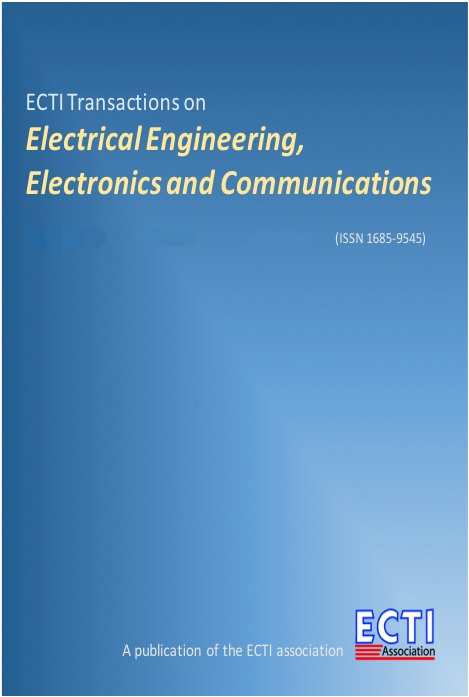A Photovoltaic Cell Energy Transfer System Using Series-Connected Bidirectional Resonant Converters
Main Article Content
Abstract
This paper presents an energy transfer system for a photovoltaic module with solar-powered panels, batteries, and a grid-tie inverter that uses series-connected bidirectional resonant converters. The purpose of this study is to investigate the asymmetrical duty cycle control and frequency control techniques for increasing and controlling the input voltage of the grid-tie inverter. Prior to the experiment, the performance of the bidirectional resonant converters was evaluated using a simulation program. By adjusting the asymmetrical duty cycle by 50%, the input voltage of the grid inverter was found to be 48.2 V. However, by adjusting the asymmetrical duty cycle by 10%, the input voltage of the grid inverter was 150.4 V. Furthermore, when turning on the switch in the zero-voltage switching (ZVS) mode, the converter circuit was controlled and operated within an appropriate frequency range. The results revealed no switching losses when the converters were turned on. As a result, the bidirectional resonant converters were able to properly transfer energy and regulate the input voltage of the grid inverter.
Article Details

This work is licensed under a Creative Commons Attribution-NonCommercial-NoDerivatives 4.0 International License.
This journal provides immediate open access to its content on the principle that making research freely available to the public supports a greater global exchange of knowledge.
- Creative Commons Copyright License
The journal allows readers to download and share all published articles as long as they properly cite such articles; however, they cannot change them or use them commercially. This is classified as CC BY-NC-ND for the creative commons license.
- Retention of Copyright and Publishing Rights
The journal allows the authors of the published articles to hold copyrights and publishing rights without restrictions.
References
J. Davies and P. Simpson, Induction Heating Handbook. New York, NY, USA: McGraw-Hill, 1979.
W. D. Stanley, Operational Amplifiers with Linear Integrated Circuits, 3rd ed. New York, NY, USA: Merrill, 1994, pp. 29–32.
J. M. Jacob, Industrial Control Electronics: Applications and Design.Singapore: Simon & Schuster, 1995, pp. 296–297.
H. Koertzen, J. van Wyk, and J. Ferreira, “Design of the half-bridge, series resonant converter for induction cooking,” in Proceedings of PESC ’95 - Power Electronics Specialist Conference, 1995, pp. 729–735.
D. Pimentel, A. Cheriti, M. B. Slima, and P. Sicard, “Pulse density modulation pattern optimization using genetic algorithms,” in 32nd Annual Conference on IEEE Industrial Electronics (IECON 2006), 2006, pp. 1655–1660.
E. Dede, V. Esteve, J. Garcia, A. Navarro, and J. Carrasco, “On the design of high frequency series resonant converters for induction heating applications,” in Proceedings of IECON ’93 - 19th Annual Conference of IEEE Industrial Electronics, 1993, pp. 1303–1307.
T. Nussbaumer, M. Baumann, and J. W. Kolar, “Comprehensive design of a three-phase three-switch buck-type PWM rectifier,” IEEE Transactions on Power Electronics, vol. 22, no. 2, pp. 551–562, Mar. 2007.
S. Chudjuarjeen and C. Koompai, “A high-frequency induction cooker using qusai-resonant converter,” in 2007 4th International Conference on Electrical Engineering/Electronics, Computer, Telecommunications and Information Technology (ECTI-CON 2007), 2007, pp. 378–381.
S. Chudjuarjeen and C. Koompai, “Asymmetrical control with phase lock loop for induction cooking appliances,” in 2008 5th International Conference on Electrical Engineering/Electronics, Computer, Telecommunications and Information Technology (ECTI-CON 2008), 2008, pp. 1013–1016.
N.-J. Park, D.-Y. Lee, and D.-S. Hyun, “A power-control scheme with constant switching frequency in class-d inverter for induction-heating jar application,” IEEE Transactions on Industrial Electronics, vol. 54, no. 3, pp. 1252–1260, Jun. 2007.
L. de Vicuna, M. Castilla, J. Miret, J. Matas, and J. Guerrero, “Sliding-mode control for a single-phase AC/AC quantum resonant converter,” IEEE Transactions on Industrial Electronics, vol. 56, no. 9, pp. 3496–3504, Sep. 2009.
M.-K. Nguyen, Y.-G. Jung, and Y.-C. Lim, “Single-phase AC–AC converter based on quasi-z-source topology,” IEEE Transactions on Power Electronics, vol. 25, no. 8, pp. 2200–2210, Aug. 2010.
X. P. Fang, Z. M. Qian, and F. Z. Peng, “Single-phase z-source PWM AC-AC converters,” IEEE Power Electronics Letters, vol. 3, no. 4, pp. 121–124, Dec. 2005.
S. Chudjuarjeen, A. Sangswang, and C. Koompai, “An improved LLC resonant inverter for induction-heating applications with asymmetrical control,” IEEE Transactions on Industrial Electronics, vol. 58, no. 7, pp. 2915–2925, Jul. 2011.
S. Yachiangkam, A. Sangswang, S. Naetiladdanon, C. Koompai, and S. Chudjuarjeen, “Steady-state analysis of ZVS and NON-ZVS full-bridge inverters with asymmetrical control for induction heating applications,” Journal of Power Electronics, vol. 15, no. 2, pp. 544–554, Mar. 2015.
J. Jittakort, A. Sangswang, S. Naetiladdanon, C. Koompai, and S. Chudjuarjeen, “Full bridge resonant inverter using asymmetrical control with resonant-frequency tracking for ultrasonic cleaning applications,” Journal of Power Electronics, vol. 17, no. 5, pp. 1150–1159, Sep. 2017.
S. Nilboworn, K. Mahamad, W. Sangchay, and P. Kongrueang, “Edge effect and its influence on the adjacent cavities in a composite insulator,” UTK Research Journal, vol. 14, no. 1, pp. 23–29, 2020.
K. Suresh and D. R. Arulmozhiyal, “Design and implementation of bi-directional DC-DC converter for wind energy system,” Circuits and Systems, vol. 07, no. 11, pp. 3705–3722, 2016.
R. Pramanik and B. Pati, “Modelling and control of a non-isolated half-bridge bidirectional DC-DC converter with an energy management topology applicable with EV/HEV,” Journal of King Saud University - Engineering Sciences, 2021.


